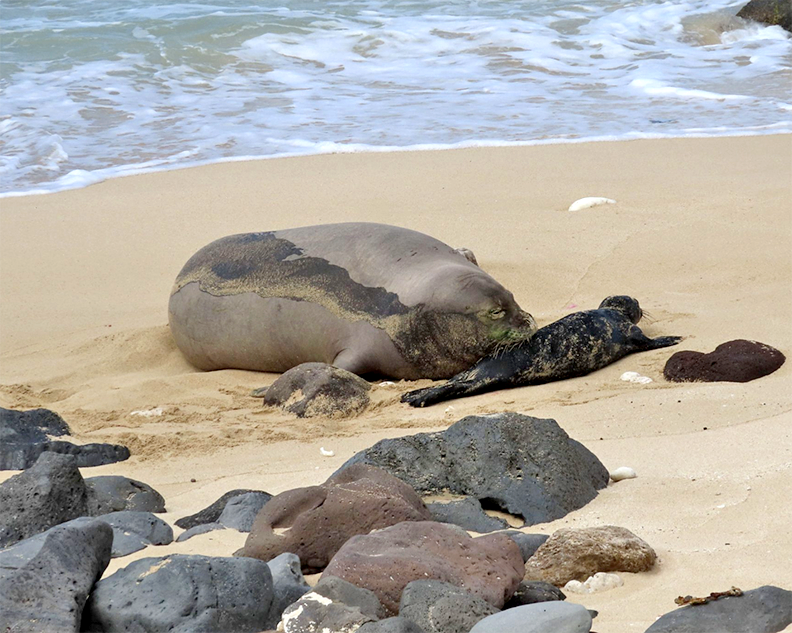By Ruby Pap

Rocky Point, O‘ahu.
If you paid any attention at all to statewide news earlier this year, you probably heard about the extreme beach erosion events at Rocky Point on O‘ahu’s North Shore.
Pictures of homes on the brink of falling into the sea provide us with a glimpse of what we can expect from accelerated sea level rise due to global warming.
Sea level change is driven by two major forces: Local tectonic processes; and global sea level change from thermal expansion of the oceans and ice melt from global warming.
All of the islands have been subsiding at various rates from the weight of the actively growing volcano on the Big Island. The Nawiliwili tide gauge shows Kaua‘i’s historical sea level rise at 1.54 mm/year.
Factoring in the predicted global sea level rise due to global warming, the numbers get larger.

Kekaha Beach Park, Kaua‘i’s Westside.
In 2012, the U.S. National Academy of Sciences predicted sea level rise of 3-9 inches by 2030; 7-18 inches by 2050; and 19-55 inches by 2100 (1). These numbers are consistent with the ranges predicted by the Intergovernmental Panel on Climate Change (2). Other studies predict as much as 6 feet of sea level rise by 2100 (3).
The National Oceanic and Atmospheric Administration’s Digital Coast Online sea level rise viewer is a good interactive tool to see what various sea level rise scenarios could look like for flooding on Kaua‘i. (csc.noaa.gov/digitalcoast/tools/slrviewer)
In addition to flooding, we can expect to see beach erosion, saltwater intrusion into wetlands and groundwater. Homes, critical infrastructure such as roads and bridges, and other facilities will be threatened in increasing numbers.
According to the IPCC, “Human influence has been detected in warming of the atmosphere and the ocean, in changes in the global water cycle, in reductions in snow and ice, in global mean sea level rise, and in changes in some climate extremes …” (4)
It can be frustrating to think that the impacts we are faced with are in part caused by industrial practices miles away. However, we all have a part to play, and efforts to mitigate greenhouse gas emissions, such as renewable energy transition, and smart growth planning aimed at reducing automobile use are essential.
There is also much we can do to adapt. The adaptation continuum starts with awareness (e.g. supporting scientific investigation), continues with developing a shared vision of what’s at risk (e.g. mapping the problems), and then planning for the future (e.g. land use and restoration planning).
Sea level rise adaptation planning options include: “accommodation,” or planning and retrofitting our communities to accommodate rising seas; “retreat” of development away from the shoreline; and “protection” or “hold the line” approaches such as building seawalls to protect critical infrastructure.
In the coming months and years, you will probably come across opportunities to be involved in community conversations on this important issue. Or, perhaps you will start one of your own? In either case, I hope this short article provides helpful information that empowers you to seek out more.
- Ruby Pap is a Coastal Land Use Extension Agent at University of Hawai‘i Sea Grant College Program. She can be reached at rpap@hawaii.edu
1. National Research Council. Sea-Level Rise for the Coasts of California, Oregon, and Washington: Past, Present, and Future. Washington, DC: The National Academies Press, 2012.
2. IPCC, 2013: Summary for Policymakers. In: Climate Change 2013: The Physical Science Basis. Contribution of Working Group I to the Fifth Assessment Report of the Intergovernmental Panel on Climate Change
3. See Parris, A., P. Bromirski, V. Burkett, D. Cayan, M. Culver, J. Hall, R. Horton, K. Knuuti, R. Moss, J. Obeysekera, A. Sallenger, and J. Weiss. 2012. Global Sea Level Rise Scenarios for the US National Climate Assessment. NOAA Tech Memo OAR CPO-1. 37 pp.
4. IPCC, 2013: Headline Statements from the Summary for Policymakers.p. 2. In: Climate Change 2013: The Physical Science Basis. Contribution of Working Group I to the Fifth Assessment Report of the Intergovernmental Panel on Climate Change [Stocker, T.F., D. Qin, G.-K. Plattner, M. Tignor, S. K. Allen, J. Boschung, A. Nauels, Y. Xia, V. Bex and P.M. Midgley (eds.)]. Cambridge University Press, Cambridge, United Kingdom and New York, NY, USA.
Discover more from ForKauaiOnline
Subscribe to get the latest posts sent to your email.





Leave a Reply